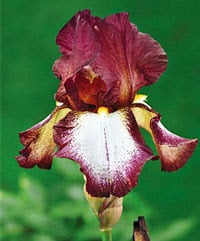Summer Care for Tall Bearded Iris
What to do with bearded irises when the show is over.
 Majestic, tall bearded irises reign in the early summer garden. Photo from the garden of Leo Vandervlugt, president of Dutch Gardens.
Majestic, tall bearded irises reign in the early summer garden. Photo from the garden of Leo Vandervlugt, president of Dutch Gardens.
By mid-summer, nothing remains of my bearded irises’ glorious color and fanfare. The tall, once-stately stalks hold nothing but shriveled brown flowers. Papery, canoe-shaped bracts protect the developing seedpods along the stems.
Removing spent flowers is one of my favorite gardening activities because the whole garden looks tidier when I’m finished. Deadheading irises is especially satisfying because the empty stalks look so forlorn. It’s also important to the vigor and future flowering of the plants. Removing the seedpods allows the plants to concentrate their energy on growing strong roots, rhizomes, and leaves. Large rhizomes produce more flowers.
Deadheading also takes a potential disease source out of the garden. Botrytis and other fungal diseases abound in damp weather. They proliferate on flowers that remain wet, turning them brown and mushy. The fungus can spread and cause brown spots on the foliage of surrounding plants.
As soon as the last flower has wilted, I use a sharp pair of pruners or scissors to cut the stalks down to where they emerge from the foliage. While I’m down there, I look over the rhizomes and foliage and check for potential problems.
The main trouble I’m looking for is iris borer. The grubs of this moth tunnel through iris rhizomes and allow disease to enter, which often kills the plant. The grubs grow to 1 to 1-1/2” length in midsummer, then leave the rhizome to pupate in the soil. Signs of iris borer infestation include watery streaks down the leaves, sawdust around the rhizomes, and foliage wilt.
 Rock Star is one of this year’s new varieties at Dutch Gardens.
Rock Star is one of this year’s new varieties at Dutch Gardens.
When I’m cutting down iris stalks, I also look for crowded clumps that need dividing. The best time to divide bearded iris is in July and August, so that the replanted rhizomes have time to grow plenty of roots before they go dormant for winter.
For even more information, visit the American Iris Society. It’s a great resource for more information and links to local iris groups.
Print this Article:
Get the Dirt
Stay up to date on new articles and advice. Please fill out the information below.

